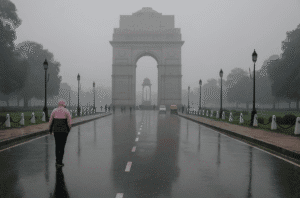Delhi’s Unseasonal Chill: 5 Shocking Weather Events That Will Leave You Speechless
Delhi witnessed an unexpected weather shift this week as thunderstorms and heavy rain disrupted the city’s typical May heat, offering temporary relief but also chaos. Temperatures plummeted to 32.3°C (7° below average) during the day and 23.2°C at night, marking unseasonal lows. Friday’s intense downpour broke records, dumping 77mm of rain in six hours—the second-highest May rainfall since 1901—triggering waterlogging, traffic snarls, and tree uprooting in areas like Dwarka and RK Puram.
The India Meteorological Department (IMD) issued red alerts, warning of 70–80 km/h winds and hailstorms, urging residents to avoid open spaces. While air quality improved to a “moderate” AQI of 119, experts caution this respite may be short-lived. The erratic weather, attributed to rare clashes between western disturbances and Bay of Bengal moisture, underscores growing climate unpredictability. As IMD forecasts more storms, the city grapples with balancing relief from heatwaves against infrastructure unpreparedness for sudden deluges.

Delhi’s Unseasonal Chill: 5 Shocking Weather Events That Will Leave You Speechless
Delhi residents experienced an unexpected reprieve from the summer heat this week as thunderstorms and rain swept across the capital, plunging temperatures to unseasonable lows and disrupting daily life. The India Meteorological Department (IMD) has forecast continued weather turbulence, including thunderstorms and gusty winds, with temperatures hovering around 23–32°C over the coming days.
Record-Breaking Rainfall and Cooling Temperatures
On Monday, Delhi recorded a maximum temperature of 32.3°C—a stark seven degrees below the seasonal average—while nighttime lows dipped to 23.2°C, 1.5 degrees cooler than usual. This chill follows Friday’s historic downpour, which dumped 77 mm of rain in just six hours at Safdarjung, marking the second-highest 24-hour May rainfall since 1901. The deluge disrupted traffic, caused waterlogging in key areas like Dwarka and RK Puram, and uprooted trees, highlighting the city’s vulnerability to sudden weather shifts.
Weather Whiplash: From Heatwave to Thunderstorms
The abrupt transition from a punishing heatwave to stormy skies left many residents scrambling for cover. Last week’s red alert from the IMD warned of severe thunderstorms with winds reaching 70–80 km/h, alongside isolated hailstorms. While the rains brought much-needed relief from soaring temperatures, they also exposed infrastructure gaps, with power outages and flooded streets paralyzing parts of the city. Authorities urged citizens to stay indoors, avoid trees, and unplug electronics to mitigate risks.
Air Quality Improves, But Challenges Remain
The rainfall temporarily boosted Delhi’s air quality, with the Air Quality Index (AQI) registering a “moderate” 119 on Monday. However, experts caution that this improvement is likely short-lived. The Central Pollution Control Board (CPCB) classifies an AQI of 101–200 as “moderate,” posing minor health risks for sensitive groups. While the rain helped settle pollutants, ongoing construction and vehicular emissions could quickly reverse gains once dry conditions return.
Why May’s Weather Is Defying Norms
Meteorologists attribute the unseasonal coolness and rain to active western disturbances—weather systems originating from the Mediterranean—that have collided with moist winds from the Bay of Bengal. These interactions are rare in May, a month typically marked by pre-monsoon heat. While such events provide temporary relief, they also raise concerns about increasingly erratic weather patterns linked to climate change.
Looking Ahead: IMD’s Advisory for Residents
The IMD predicts continued thunderstorms and light rain through the week, urging Delhiites to stay alert for sudden weather changes. Residents are advised to:
- Avoid open areas during storms.
- Secure loose outdoor objects to prevent wind damage.
- Monitor updates for traffic disruptions and waterlogging.
While the rain has quenched Delhi’s parched landscapes and cleared the air, it serves as a reminder of the city’s fragile balance between urban growth and climate resilience. As weather extremes become more frequent, adapting infrastructure and public awareness will be key to navigating future storms.
You must be logged in to post a comment.